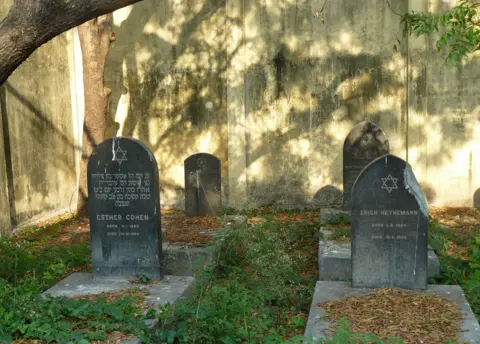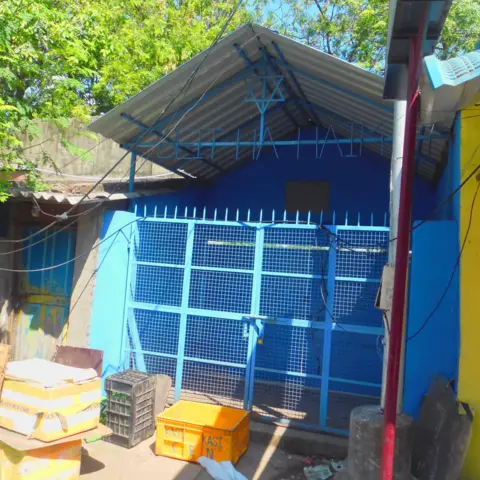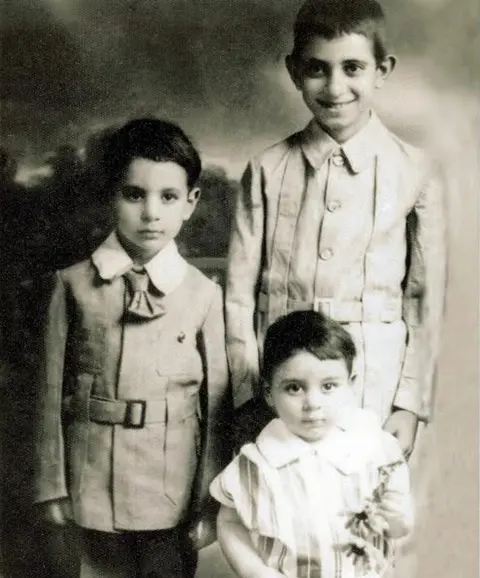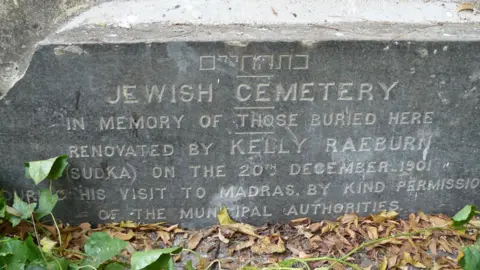Uncovering a story of ill-fated romance and tragic death
 Nancy Hennigar Reisig
Nancy Hennigar ReisigNot so long ago, the Jews of Baghdad were one of the great trading communities in Asia. In the southern Indian port city of Chennai - Madras, as it once was - Andrew Whitehead came across a last remnant of the Jewish presence there, and stumbled on a tragic love story.
I was told the place would be difficult to find - tucked away on a busy market street not far from Marina beach, with stalls obscuring the entrance. But I spotted the star of David standing proud. The gates had recently been painted sky blue, and over the entrance were the words Beit Ha Haim, Hebrew for The House Of Life. In other words, a Jewish cemetery.

The gates were padlocked. One of the market women gestured to me to wait - she got out her phone - another woman found me a plastic chair and assured me, "Someone coming."
Half-an-hour later, Kumari appeared - a bustling, well set woman in a pink sari. She had a bunch of keys, and within a couple of minutes I was ushered into a tiny graveyard, little bigger than a badminton court. It was a touch forlorn-looking, but clearly well-kept. And in case I hadn't cottoned on who was responsible for the upkeep, Kumari wielded her broom energetically to clear leaves from the gravestones.
The synagogue in what was Madras was demolished decades ago. The city now has no Jewish community, though some say there are still a few individuals. The cemetery is just about all that's left, and that's moved, perhaps twice, down the years. Only a handful of the older graves have survived, the most substantial that of Abraham Salomons, a coral merchant, who died in 1745.
There's a handful of 20th Century graves. One caught my eye - a woman who died in 1943 in her early twenties, Victoria M Sofaer. What was the story behind that early death?

Well, there's a family history website devoted to the Sephardic Jewish diaspora. Victoria - I discovered - was known as Toyah, and born in Baghdad. But curiously, her family didn't know about her grave - or exactly when or where Toyah died.
Through that website, I made contact with Toyah's niece - and indirectly with Toyah's half-brother, Abraham, now 94 and living in a nursing home in Toronto. He was born two years after Toyah and was the closest to her in the family. They were surprised to learn of Toyah's grave. In turn they unsettled me with the troubling story of Toyah's life and death - barely known even within the family, and never rehearsed beyond its bounds.
Toyah's father, Menashi, was the proprietor of the British General Supply Store in Baghdad in the 1920s and 1930s. They imported Swiss cheese, French brandy, American cigarettes, Belgian chocolate, and had a grand shop on Rashid Street, Baghdad's main street back then.
In 1940 or thereabouts, Toyah fell in love with an Armenian man from the family that ran the ladies' wear shop on the other side of the street. Her family found out. They were determined to put a stop to the romance. They tried to find a Jewish groom - she turned them all down. So they shipped Toyah out - to India.

Find out more
- From Our Own Correspondent has insight and analysis from BBC journalists, correspondents and writers from around the world
- Listen on iPlayer, get the podcast or listen on the BBC World Service or on Radio 4 on Saturdays at 11:30 and Thursdays at 11:00

Abraham, Toyah's half-brother, was then living in Bombay to avoid service in the Iraqi army. Late in 1942, his parents turned up there with Toyah in tow.
"She was in complete shock, silent - she never said a word to me", he recalls. "It saddened me greatly."

After a while, Toyah and her parents moved on - he wasn't told where. Then he heard that Toyah had died. And their parents returned to Baghdad. They didn't talk about what happened. It was only later that Abraham found out from his grandmother about Toyah's transgressive romance. "I believe my sister died from a broken heart," he says.
I asked if there were any likenesses of Toyah. I was sent a family portrait of three boys. Toyah would have been seven at the time. Why wasn't she included? She had been! When she died, her parents retouched the photo to remove her image. Done - says Toyah's niece - so that there was no reminder of the scandal and the tragedy.

Another photo has emerged. It may, just may, include Toyah. A serious looking young girl with tousled hair, no-one's quite sure if it's her - and more than 70 years after her death, I guess we'll never know.
Toyah's brother is comforted to know she has a proper grave, and to be able to talk within the family about the fate his sister suffered. It's offered him some closure and given his sister public acknowledgement of the wrong done to her.
His daughter dropped me a line. "Bringing back memories of Toyah", she said, "is incredibly moving for us."
It is for me too.
 Nancy Hennigar Reisig
Nancy Hennigar Reisig
